ICMS MGT604: Global Context Management and Analysis Essay
VerifiedAdded on 2023/03/30
|13
|3426
|396
Essay
AI Summary
This essay examines the multifaceted aspects of managing in a global context, addressing the challenges and opportunities faced by international organizations. It explores the significance of socio-cultural contexts, analyzing how communication, etiquette, and organizational hierarchy influence business operations across different cultures. The essay delves into organizational behavior, evaluating its impact on work attitudes and practices at both individual and group levels, while also examining the effects of national culture mediated by organizational practices. Furthermore, it applies advanced theoretical concepts to address contemporary global management issues, such as globalization, innovation, and employee satisfaction. The analysis includes critical evaluation of cultural attributes and their role in management decision-making, emphasizing the importance of critical thinking, leadership, and problem-solving to enhance organizational performance and stakeholder engagement. The essay concludes with recommendations for effective global management strategies, emphasizing the importance of adapting to cultural nuances and fostering strong leadership to drive organizational success.

Managing in global context
Paraphrase This Document
Need a fresh take? Get an instant paraphrase of this document with our AI Paraphraser
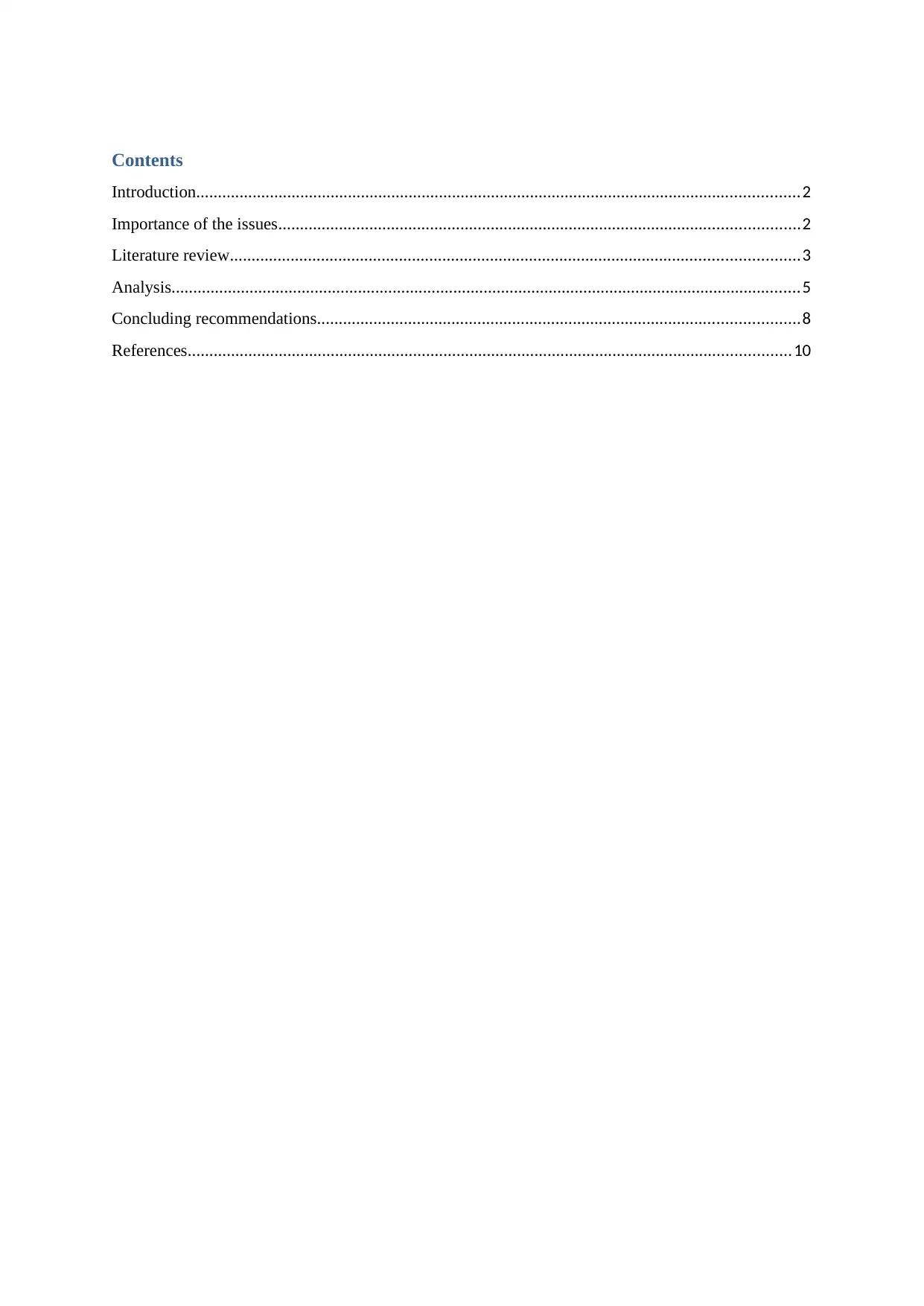
Contents
Introduction...........................................................................................................................................2
Importance of the issues........................................................................................................................2
Literature review...................................................................................................................................3
Analysis.................................................................................................................................................5
Concluding recommendations...............................................................................................................8
References...........................................................................................................................................10
Introduction...........................................................................................................................................2
Importance of the issues........................................................................................................................2
Literature review...................................................................................................................................3
Analysis.................................................................................................................................................5
Concluding recommendations...............................................................................................................8
References...........................................................................................................................................10
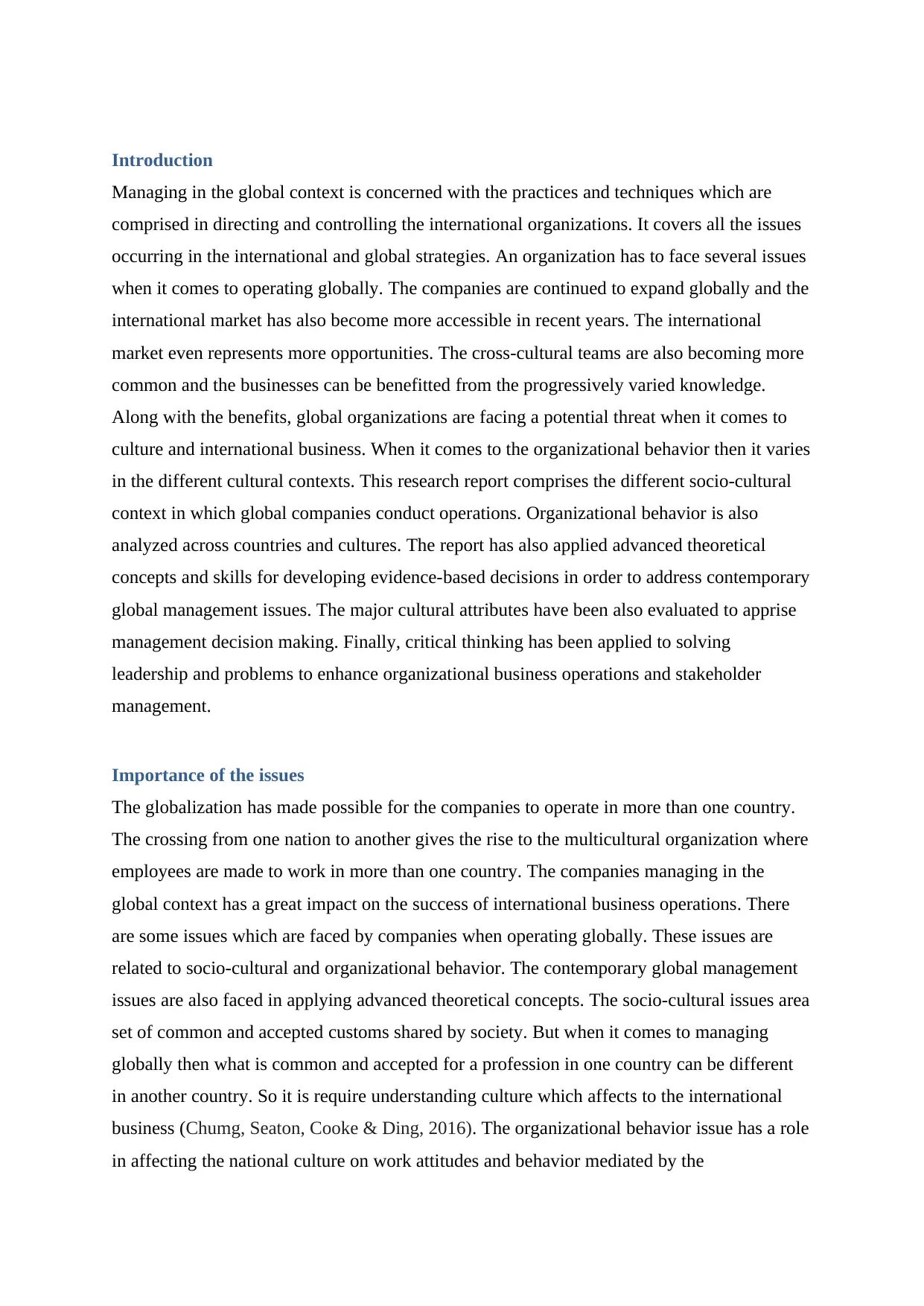
Introduction
Managing in the global context is concerned with the practices and techniques which are
comprised in directing and controlling the international organizations. It covers all the issues
occurring in the international and global strategies. An organization has to face several issues
when it comes to operating globally. The companies are continued to expand globally and the
international market has also become more accessible in recent years. The international
market even represents more opportunities. The cross-cultural teams are also becoming more
common and the businesses can be benefitted from the progressively varied knowledge.
Along with the benefits, global organizations are facing a potential threat when it comes to
culture and international business. When it comes to the organizational behavior then it varies
in the different cultural contexts. This research report comprises the different socio-cultural
context in which global companies conduct operations. Organizational behavior is also
analyzed across countries and cultures. The report has also applied advanced theoretical
concepts and skills for developing evidence-based decisions in order to address contemporary
global management issues. The major cultural attributes have been also evaluated to apprise
management decision making. Finally, critical thinking has been applied to solving
leadership and problems to enhance organizational business operations and stakeholder
management.
Importance of the issues
The globalization has made possible for the companies to operate in more than one country.
The crossing from one nation to another gives the rise to the multicultural organization where
employees are made to work in more than one country. The companies managing in the
global context has a great impact on the success of international business operations. There
are some issues which are faced by companies when operating globally. These issues are
related to socio-cultural and organizational behavior. The contemporary global management
issues are also faced in applying advanced theoretical concepts. The socio-cultural issues area
set of common and accepted customs shared by society. But when it comes to managing
globally then what is common and accepted for a profession in one country can be different
in another country. So it is require understanding culture which affects to the international
business (Chumg, Seaton, Cooke & Ding, 2016). The organizational behavior issue has a role
in affecting the national culture on work attitudes and behavior mediated by the
Managing in the global context is concerned with the practices and techniques which are
comprised in directing and controlling the international organizations. It covers all the issues
occurring in the international and global strategies. An organization has to face several issues
when it comes to operating globally. The companies are continued to expand globally and the
international market has also become more accessible in recent years. The international
market even represents more opportunities. The cross-cultural teams are also becoming more
common and the businesses can be benefitted from the progressively varied knowledge.
Along with the benefits, global organizations are facing a potential threat when it comes to
culture and international business. When it comes to the organizational behavior then it varies
in the different cultural contexts. This research report comprises the different socio-cultural
context in which global companies conduct operations. Organizational behavior is also
analyzed across countries and cultures. The report has also applied advanced theoretical
concepts and skills for developing evidence-based decisions in order to address contemporary
global management issues. The major cultural attributes have been also evaluated to apprise
management decision making. Finally, critical thinking has been applied to solving
leadership and problems to enhance organizational business operations and stakeholder
management.
Importance of the issues
The globalization has made possible for the companies to operate in more than one country.
The crossing from one nation to another gives the rise to the multicultural organization where
employees are made to work in more than one country. The companies managing in the
global context has a great impact on the success of international business operations. There
are some issues which are faced by companies when operating globally. These issues are
related to socio-cultural and organizational behavior. The contemporary global management
issues are also faced in applying advanced theoretical concepts. The socio-cultural issues area
set of common and accepted customs shared by society. But when it comes to managing
globally then what is common and accepted for a profession in one country can be different
in another country. So it is require understanding culture which affects to the international
business (Chumg, Seaton, Cooke & Ding, 2016). The organizational behavior issue has a role
in affecting the national culture on work attitudes and behavior mediated by the
⊘ This is a preview!⊘
Do you want full access?
Subscribe today to unlock all pages.

Trusted by 1+ million students worldwide
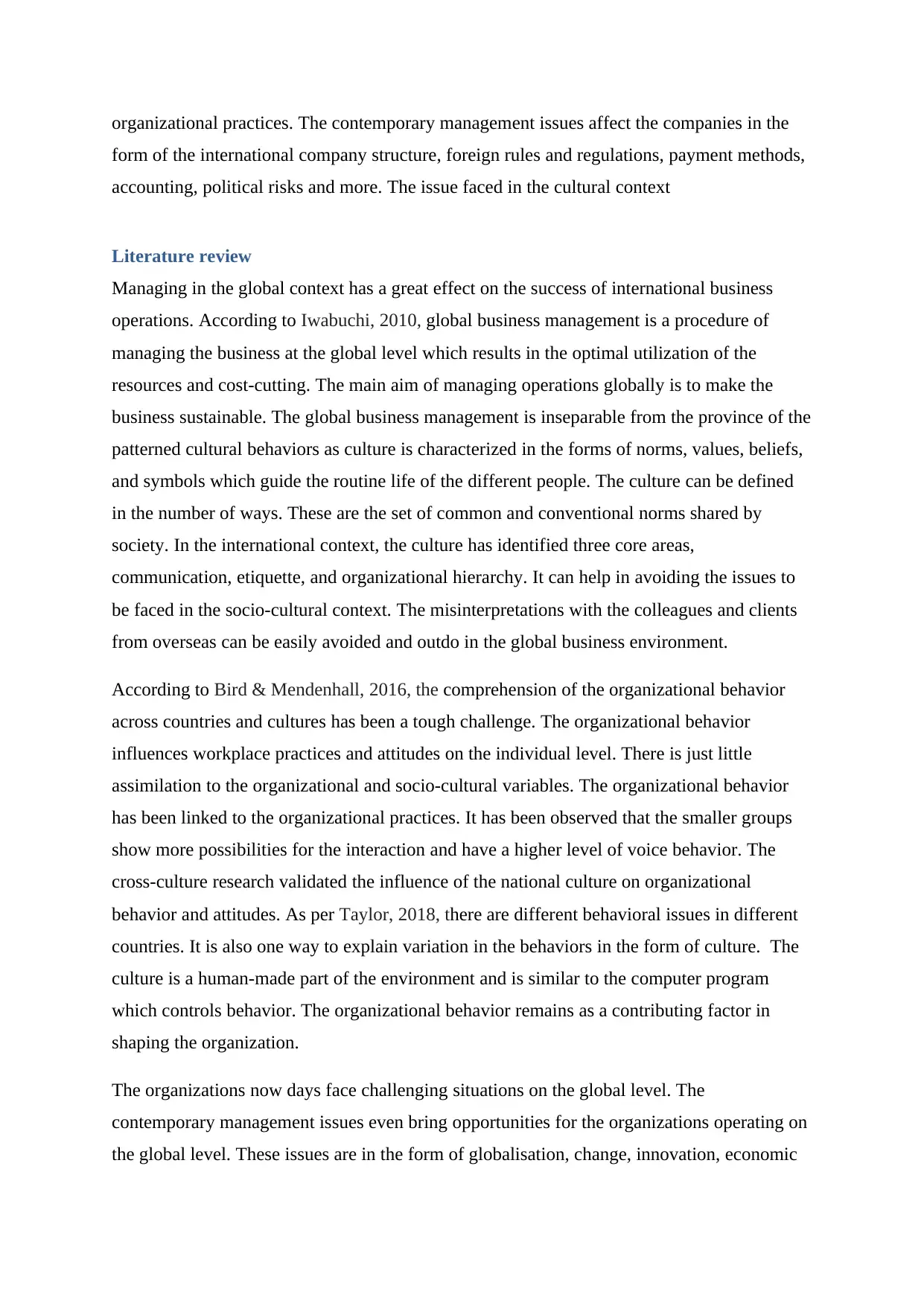
organizational practices. The contemporary management issues affect the companies in the
form of the international company structure, foreign rules and regulations, payment methods,
accounting, political risks and more. The issue faced in the cultural context
Literature review
Managing in the global context has a great effect on the success of international business
operations. According to Iwabuchi, 2010, global business management is a procedure of
managing the business at the global level which results in the optimal utilization of the
resources and cost-cutting. The main aim of managing operations globally is to make the
business sustainable. The global business management is inseparable from the province of the
patterned cultural behaviors as culture is characterized in the forms of norms, values, beliefs,
and symbols which guide the routine life of the different people. The culture can be defined
in the number of ways. These are the set of common and conventional norms shared by
society. In the international context, the culture has identified three core areas,
communication, etiquette, and organizational hierarchy. It can help in avoiding the issues to
be faced in the socio-cultural context. The misinterpretations with the colleagues and clients
from overseas can be easily avoided and outdo in the global business environment.
According to Bird & Mendenhall, 2016, the comprehension of the organizational behavior
across countries and cultures has been a tough challenge. The organizational behavior
influences workplace practices and attitudes on the individual level. There is just little
assimilation to the organizational and socio-cultural variables. The organizational behavior
has been linked to the organizational practices. It has been observed that the smaller groups
show more possibilities for the interaction and have a higher level of voice behavior. The
cross-culture research validated the influence of the national culture on organizational
behavior and attitudes. As per Taylor, 2018, there are different behavioral issues in different
countries. It is also one way to explain variation in the behaviors in the form of culture. The
culture is a human-made part of the environment and is similar to the computer program
which controls behavior. The organizational behavior remains as a contributing factor in
shaping the organization.
The organizations now days face challenging situations on the global level. The
contemporary management issues even bring opportunities for the organizations operating on
the global level. These issues are in the form of globalisation, change, innovation, economic
form of the international company structure, foreign rules and regulations, payment methods,
accounting, political risks and more. The issue faced in the cultural context
Literature review
Managing in the global context has a great effect on the success of international business
operations. According to Iwabuchi, 2010, global business management is a procedure of
managing the business at the global level which results in the optimal utilization of the
resources and cost-cutting. The main aim of managing operations globally is to make the
business sustainable. The global business management is inseparable from the province of the
patterned cultural behaviors as culture is characterized in the forms of norms, values, beliefs,
and symbols which guide the routine life of the different people. The culture can be defined
in the number of ways. These are the set of common and conventional norms shared by
society. In the international context, the culture has identified three core areas,
communication, etiquette, and organizational hierarchy. It can help in avoiding the issues to
be faced in the socio-cultural context. The misinterpretations with the colleagues and clients
from overseas can be easily avoided and outdo in the global business environment.
According to Bird & Mendenhall, 2016, the comprehension of the organizational behavior
across countries and cultures has been a tough challenge. The organizational behavior
influences workplace practices and attitudes on the individual level. There is just little
assimilation to the organizational and socio-cultural variables. The organizational behavior
has been linked to the organizational practices. It has been observed that the smaller groups
show more possibilities for the interaction and have a higher level of voice behavior. The
cross-culture research validated the influence of the national culture on organizational
behavior and attitudes. As per Taylor, 2018, there are different behavioral issues in different
countries. It is also one way to explain variation in the behaviors in the form of culture. The
culture is a human-made part of the environment and is similar to the computer program
which controls behavior. The organizational behavior remains as a contributing factor in
shaping the organization.
The organizations now days face challenging situations on the global level. The
contemporary management issues even bring opportunities for the organizations operating on
the global level. These issues are in the form of globalisation, change, innovation, economic
Paraphrase This Document
Need a fresh take? Get an instant paraphrase of this document with our AI Paraphraser
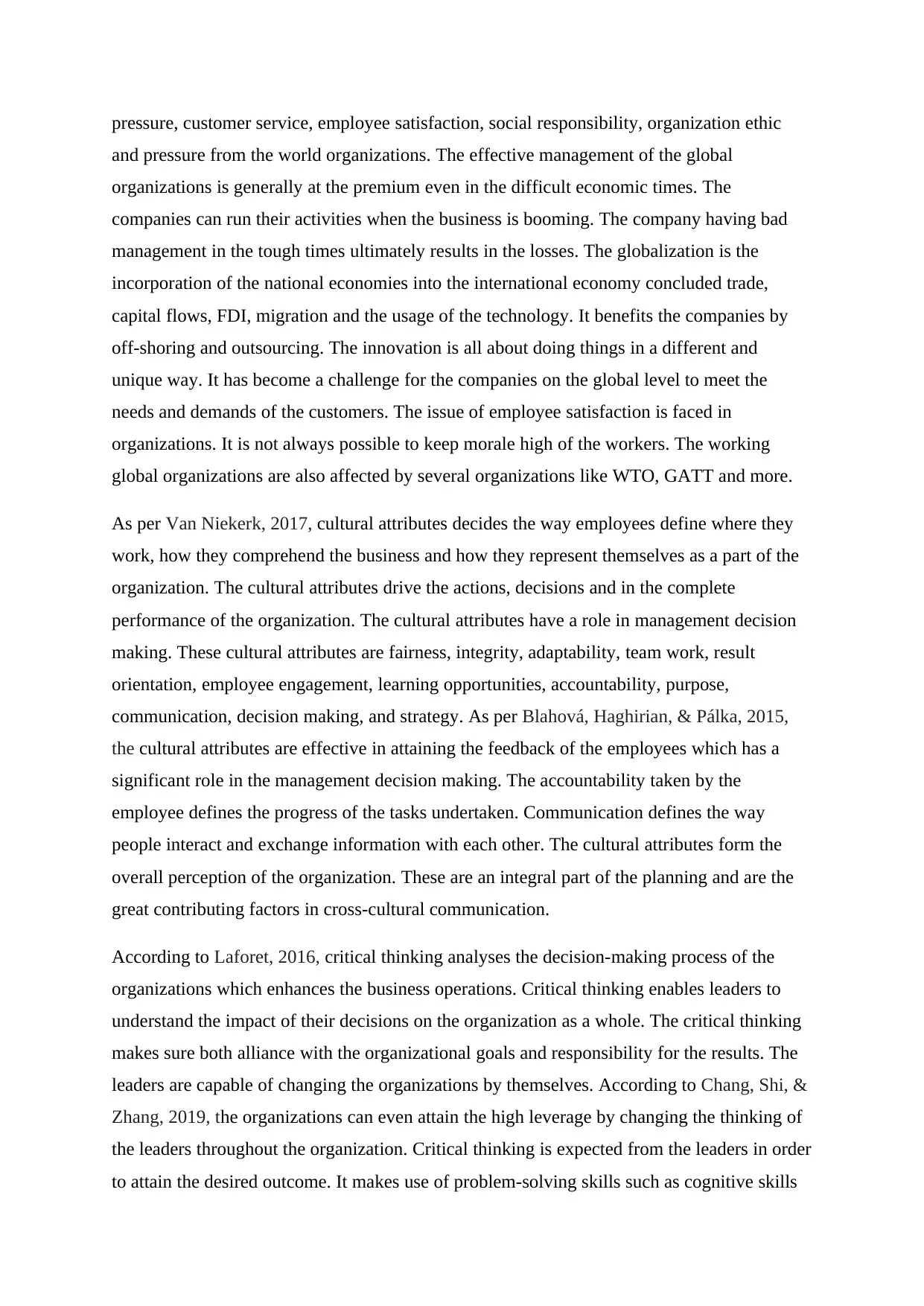
pressure, customer service, employee satisfaction, social responsibility, organization ethic
and pressure from the world organizations. The effective management of the global
organizations is generally at the premium even in the difficult economic times. The
companies can run their activities when the business is booming. The company having bad
management in the tough times ultimately results in the losses. The globalization is the
incorporation of the national economies into the international economy concluded trade,
capital flows, FDI, migration and the usage of the technology. It benefits the companies by
off-shoring and outsourcing. The innovation is all about doing things in a different and
unique way. It has become a challenge for the companies on the global level to meet the
needs and demands of the customers. The issue of employee satisfaction is faced in
organizations. It is not always possible to keep morale high of the workers. The working
global organizations are also affected by several organizations like WTO, GATT and more.
As per Van Niekerk, 2017, cultural attributes decides the way employees define where they
work, how they comprehend the business and how they represent themselves as a part of the
organization. The cultural attributes drive the actions, decisions and in the complete
performance of the organization. The cultural attributes have a role in management decision
making. These cultural attributes are fairness, integrity, adaptability, team work, result
orientation, employee engagement, learning opportunities, accountability, purpose,
communication, decision making, and strategy. As per Blahová, Haghirian, & Pálka, 2015,
the cultural attributes are effective in attaining the feedback of the employees which has a
significant role in the management decision making. The accountability taken by the
employee defines the progress of the tasks undertaken. Communication defines the way
people interact and exchange information with each other. The cultural attributes form the
overall perception of the organization. These are an integral part of the planning and are the
great contributing factors in cross-cultural communication.
According to Laforet, 2016, critical thinking analyses the decision-making process of the
organizations which enhances the business operations. Critical thinking enables leaders to
understand the impact of their decisions on the organization as a whole. The critical thinking
makes sure both alliance with the organizational goals and responsibility for the results. The
leaders are capable of changing the organizations by themselves. According to Chang, Shi, &
Zhang, 2019, the organizations can even attain the high leverage by changing the thinking of
the leaders throughout the organization. Critical thinking is expected from the leaders in order
to attain the desired outcome. It makes use of problem-solving skills such as cognitive skills
and pressure from the world organizations. The effective management of the global
organizations is generally at the premium even in the difficult economic times. The
companies can run their activities when the business is booming. The company having bad
management in the tough times ultimately results in the losses. The globalization is the
incorporation of the national economies into the international economy concluded trade,
capital flows, FDI, migration and the usage of the technology. It benefits the companies by
off-shoring and outsourcing. The innovation is all about doing things in a different and
unique way. It has become a challenge for the companies on the global level to meet the
needs and demands of the customers. The issue of employee satisfaction is faced in
organizations. It is not always possible to keep morale high of the workers. The working
global organizations are also affected by several organizations like WTO, GATT and more.
As per Van Niekerk, 2017, cultural attributes decides the way employees define where they
work, how they comprehend the business and how they represent themselves as a part of the
organization. The cultural attributes drive the actions, decisions and in the complete
performance of the organization. The cultural attributes have a role in management decision
making. These cultural attributes are fairness, integrity, adaptability, team work, result
orientation, employee engagement, learning opportunities, accountability, purpose,
communication, decision making, and strategy. As per Blahová, Haghirian, & Pálka, 2015,
the cultural attributes are effective in attaining the feedback of the employees which has a
significant role in the management decision making. The accountability taken by the
employee defines the progress of the tasks undertaken. Communication defines the way
people interact and exchange information with each other. The cultural attributes form the
overall perception of the organization. These are an integral part of the planning and are the
great contributing factors in cross-cultural communication.
According to Laforet, 2016, critical thinking analyses the decision-making process of the
organizations which enhances the business operations. Critical thinking enables leaders to
understand the impact of their decisions on the organization as a whole. The critical thinking
makes sure both alliance with the organizational goals and responsibility for the results. The
leaders are capable of changing the organizations by themselves. According to Chang, Shi, &
Zhang, 2019, the organizations can even attain the high leverage by changing the thinking of
the leaders throughout the organization. Critical thinking is expected from the leaders in order
to attain the desired outcome. It makes use of problem-solving skills such as cognitive skills
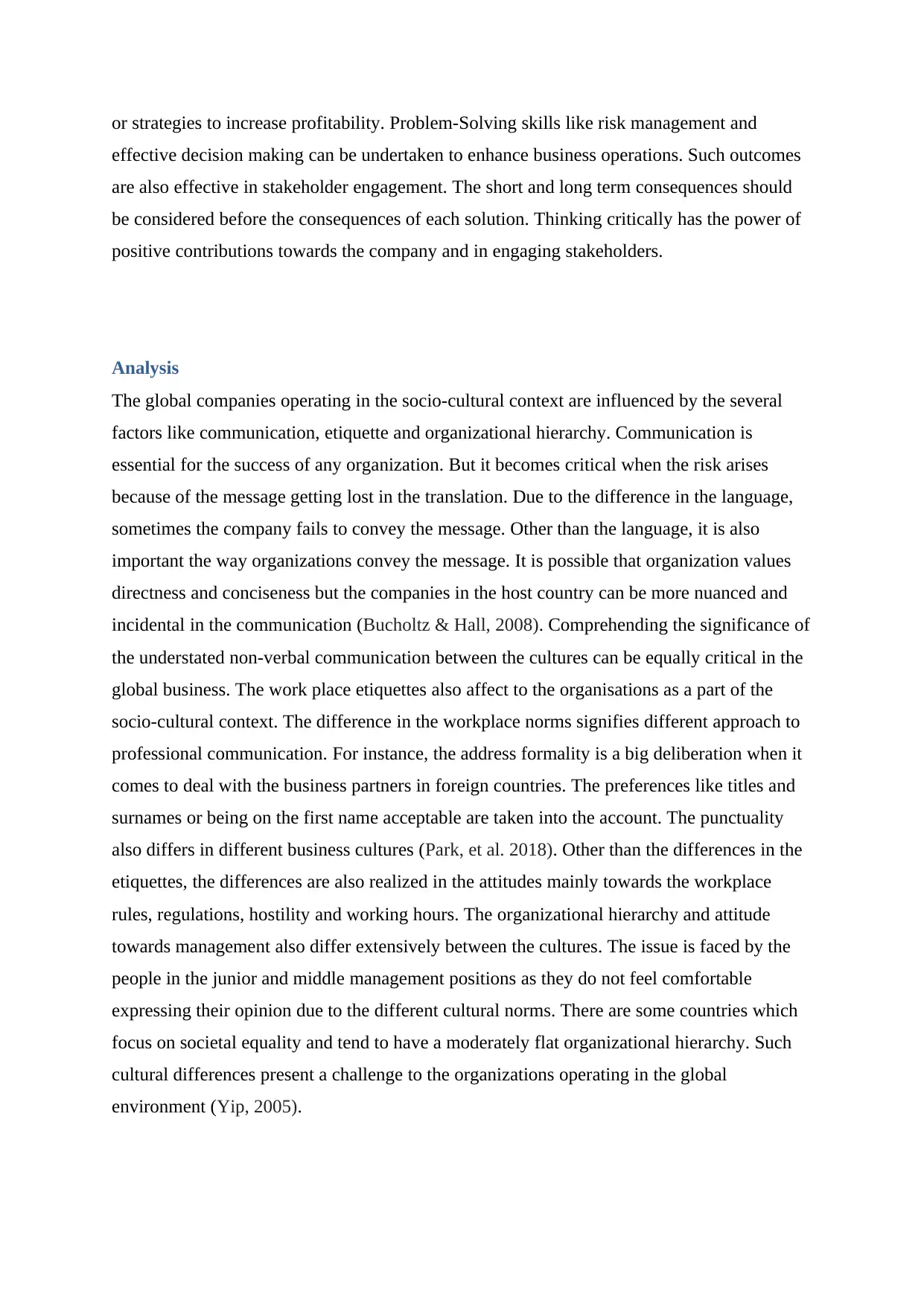
or strategies to increase profitability. Problem-Solving skills like risk management and
effective decision making can be undertaken to enhance business operations. Such outcomes
are also effective in stakeholder engagement. The short and long term consequences should
be considered before the consequences of each solution. Thinking critically has the power of
positive contributions towards the company and in engaging stakeholders.
Analysis
The global companies operating in the socio-cultural context are influenced by the several
factors like communication, etiquette and organizational hierarchy. Communication is
essential for the success of any organization. But it becomes critical when the risk arises
because of the message getting lost in the translation. Due to the difference in the language,
sometimes the company fails to convey the message. Other than the language, it is also
important the way organizations convey the message. It is possible that organization values
directness and conciseness but the companies in the host country can be more nuanced and
incidental in the communication (Bucholtz & Hall, 2008). Comprehending the significance of
the understated non-verbal communication between the cultures can be equally critical in the
global business. The work place etiquettes also affect to the organisations as a part of the
socio-cultural context. The difference in the workplace norms signifies different approach to
professional communication. For instance, the address formality is a big deliberation when it
comes to deal with the business partners in foreign countries. The preferences like titles and
surnames or being on the first name acceptable are taken into the account. The punctuality
also differs in different business cultures (Park, et al. 2018). Other than the differences in the
etiquettes, the differences are also realized in the attitudes mainly towards the workplace
rules, regulations, hostility and working hours. The organizational hierarchy and attitude
towards management also differ extensively between the cultures. The issue is faced by the
people in the junior and middle management positions as they do not feel comfortable
expressing their opinion due to the different cultural norms. There are some countries which
focus on societal equality and tend to have a moderately flat organizational hierarchy. Such
cultural differences present a challenge to the organizations operating in the global
environment (Yip, 2005).
effective decision making can be undertaken to enhance business operations. Such outcomes
are also effective in stakeholder engagement. The short and long term consequences should
be considered before the consequences of each solution. Thinking critically has the power of
positive contributions towards the company and in engaging stakeholders.
Analysis
The global companies operating in the socio-cultural context are influenced by the several
factors like communication, etiquette and organizational hierarchy. Communication is
essential for the success of any organization. But it becomes critical when the risk arises
because of the message getting lost in the translation. Due to the difference in the language,
sometimes the company fails to convey the message. Other than the language, it is also
important the way organizations convey the message. It is possible that organization values
directness and conciseness but the companies in the host country can be more nuanced and
incidental in the communication (Bucholtz & Hall, 2008). Comprehending the significance of
the understated non-verbal communication between the cultures can be equally critical in the
global business. The work place etiquettes also affect to the organisations as a part of the
socio-cultural context. The difference in the workplace norms signifies different approach to
professional communication. For instance, the address formality is a big deliberation when it
comes to deal with the business partners in foreign countries. The preferences like titles and
surnames or being on the first name acceptable are taken into the account. The punctuality
also differs in different business cultures (Park, et al. 2018). Other than the differences in the
etiquettes, the differences are also realized in the attitudes mainly towards the workplace
rules, regulations, hostility and working hours. The organizational hierarchy and attitude
towards management also differ extensively between the cultures. The issue is faced by the
people in the junior and middle management positions as they do not feel comfortable
expressing their opinion due to the different cultural norms. There are some countries which
focus on societal equality and tend to have a moderately flat organizational hierarchy. Such
cultural differences present a challenge to the organizations operating in the global
environment (Yip, 2005).
⊘ This is a preview!⊘
Do you want full access?
Subscribe today to unlock all pages.

Trusted by 1+ million students worldwide
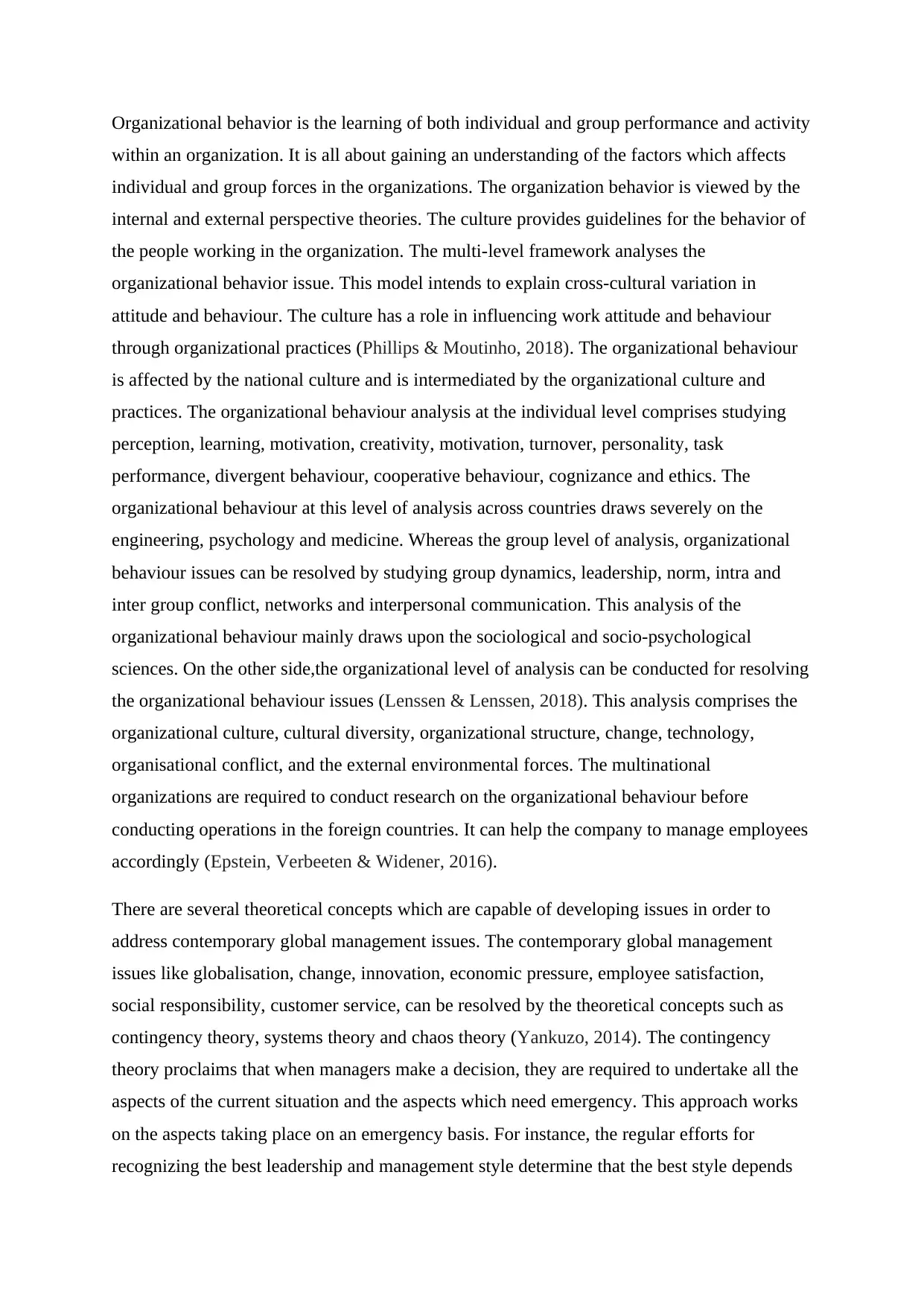
Organizational behavior is the learning of both individual and group performance and activity
within an organization. It is all about gaining an understanding of the factors which affects
individual and group forces in the organizations. The organization behavior is viewed by the
internal and external perspective theories. The culture provides guidelines for the behavior of
the people working in the organization. The multi-level framework analyses the
organizational behavior issue. This model intends to explain cross-cultural variation in
attitude and behaviour. The culture has a role in influencing work attitude and behaviour
through organizational practices (Phillips & Moutinho, 2018). The organizational behaviour
is affected by the national culture and is intermediated by the organizational culture and
practices. The organizational behaviour analysis at the individual level comprises studying
perception, learning, motivation, creativity, motivation, turnover, personality, task
performance, divergent behaviour, cooperative behaviour, cognizance and ethics. The
organizational behaviour at this level of analysis across countries draws severely on the
engineering, psychology and medicine. Whereas the group level of analysis, organizational
behaviour issues can be resolved by studying group dynamics, leadership, norm, intra and
inter group conflict, networks and interpersonal communication. This analysis of the
organizational behaviour mainly draws upon the sociological and socio-psychological
sciences. On the other side,the organizational level of analysis can be conducted for resolving
the organizational behaviour issues (Lenssen & Lenssen, 2018). This analysis comprises the
organizational culture, cultural diversity, organizational structure, change, technology,
organisational conflict, and the external environmental forces. The multinational
organizations are required to conduct research on the organizational behaviour before
conducting operations in the foreign countries. It can help the company to manage employees
accordingly (Epstein, Verbeeten & Widener, 2016).
There are several theoretical concepts which are capable of developing issues in order to
address contemporary global management issues. The contemporary global management
issues like globalisation, change, innovation, economic pressure, employee satisfaction,
social responsibility, customer service, can be resolved by the theoretical concepts such as
contingency theory, systems theory and chaos theory (Yankuzo, 2014). The contingency
theory proclaims that when managers make a decision, they are required to undertake all the
aspects of the current situation and the aspects which need emergency. This approach works
on the aspects taking place on an emergency basis. For instance, the regular efforts for
recognizing the best leadership and management style determine that the best style depends
within an organization. It is all about gaining an understanding of the factors which affects
individual and group forces in the organizations. The organization behavior is viewed by the
internal and external perspective theories. The culture provides guidelines for the behavior of
the people working in the organization. The multi-level framework analyses the
organizational behavior issue. This model intends to explain cross-cultural variation in
attitude and behaviour. The culture has a role in influencing work attitude and behaviour
through organizational practices (Phillips & Moutinho, 2018). The organizational behaviour
is affected by the national culture and is intermediated by the organizational culture and
practices. The organizational behaviour analysis at the individual level comprises studying
perception, learning, motivation, creativity, motivation, turnover, personality, task
performance, divergent behaviour, cooperative behaviour, cognizance and ethics. The
organizational behaviour at this level of analysis across countries draws severely on the
engineering, psychology and medicine. Whereas the group level of analysis, organizational
behaviour issues can be resolved by studying group dynamics, leadership, norm, intra and
inter group conflict, networks and interpersonal communication. This analysis of the
organizational behaviour mainly draws upon the sociological and socio-psychological
sciences. On the other side,the organizational level of analysis can be conducted for resolving
the organizational behaviour issues (Lenssen & Lenssen, 2018). This analysis comprises the
organizational culture, cultural diversity, organizational structure, change, technology,
organisational conflict, and the external environmental forces. The multinational
organizations are required to conduct research on the organizational behaviour before
conducting operations in the foreign countries. It can help the company to manage employees
accordingly (Epstein, Verbeeten & Widener, 2016).
There are several theoretical concepts which are capable of developing issues in order to
address contemporary global management issues. The contemporary global management
issues like globalisation, change, innovation, economic pressure, employee satisfaction,
social responsibility, customer service, can be resolved by the theoretical concepts such as
contingency theory, systems theory and chaos theory (Yankuzo, 2014). The contingency
theory proclaims that when managers make a decision, they are required to undertake all the
aspects of the current situation and the aspects which need emergency. This approach works
on the aspects taking place on an emergency basis. For instance, the regular efforts for
recognizing the best leadership and management style determine that the best style depends
Paraphrase This Document
Need a fresh take? Get an instant paraphrase of this document with our AI Paraphraser
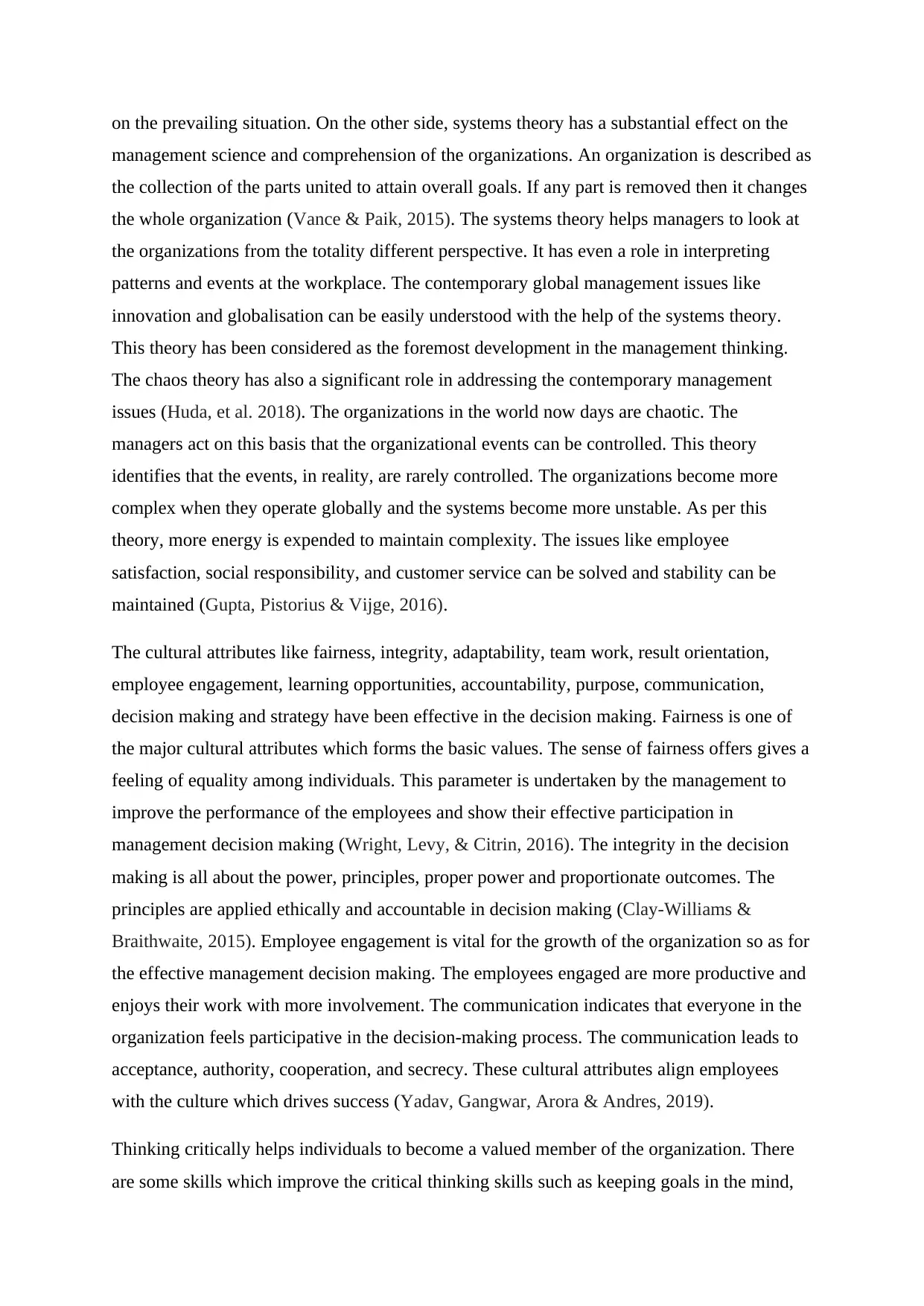
on the prevailing situation. On the other side, systems theory has a substantial effect on the
management science and comprehension of the organizations. An organization is described as
the collection of the parts united to attain overall goals. If any part is removed then it changes
the whole organization (Vance & Paik, 2015). The systems theory helps managers to look at
the organizations from the totality different perspective. It has even a role in interpreting
patterns and events at the workplace. The contemporary global management issues like
innovation and globalisation can be easily understood with the help of the systems theory.
This theory has been considered as the foremost development in the management thinking.
The chaos theory has also a significant role in addressing the contemporary management
issues (Huda, et al. 2018). The organizations in the world now days are chaotic. The
managers act on this basis that the organizational events can be controlled. This theory
identifies that the events, in reality, are rarely controlled. The organizations become more
complex when they operate globally and the systems become more unstable. As per this
theory, more energy is expended to maintain complexity. The issues like employee
satisfaction, social responsibility, and customer service can be solved and stability can be
maintained (Gupta, Pistorius & Vijge, 2016).
The cultural attributes like fairness, integrity, adaptability, team work, result orientation,
employee engagement, learning opportunities, accountability, purpose, communication,
decision making and strategy have been effective in the decision making. Fairness is one of
the major cultural attributes which forms the basic values. The sense of fairness offers gives a
feeling of equality among individuals. This parameter is undertaken by the management to
improve the performance of the employees and show their effective participation in
management decision making (Wright, Levy, & Citrin, 2016). The integrity in the decision
making is all about the power, principles, proper power and proportionate outcomes. The
principles are applied ethically and accountable in decision making (Clay-Williams &
Braithwaite, 2015). Employee engagement is vital for the growth of the organization so as for
the effective management decision making. The employees engaged are more productive and
enjoys their work with more involvement. The communication indicates that everyone in the
organization feels participative in the decision-making process. The communication leads to
acceptance, authority, cooperation, and secrecy. These cultural attributes align employees
with the culture which drives success (Yadav, Gangwar, Arora & Andres, 2019).
Thinking critically helps individuals to become a valued member of the organization. There
are some skills which improve the critical thinking skills such as keeping goals in the mind,
management science and comprehension of the organizations. An organization is described as
the collection of the parts united to attain overall goals. If any part is removed then it changes
the whole organization (Vance & Paik, 2015). The systems theory helps managers to look at
the organizations from the totality different perspective. It has even a role in interpreting
patterns and events at the workplace. The contemporary global management issues like
innovation and globalisation can be easily understood with the help of the systems theory.
This theory has been considered as the foremost development in the management thinking.
The chaos theory has also a significant role in addressing the contemporary management
issues (Huda, et al. 2018). The organizations in the world now days are chaotic. The
managers act on this basis that the organizational events can be controlled. This theory
identifies that the events, in reality, are rarely controlled. The organizations become more
complex when they operate globally and the systems become more unstable. As per this
theory, more energy is expended to maintain complexity. The issues like employee
satisfaction, social responsibility, and customer service can be solved and stability can be
maintained (Gupta, Pistorius & Vijge, 2016).
The cultural attributes like fairness, integrity, adaptability, team work, result orientation,
employee engagement, learning opportunities, accountability, purpose, communication,
decision making and strategy have been effective in the decision making. Fairness is one of
the major cultural attributes which forms the basic values. The sense of fairness offers gives a
feeling of equality among individuals. This parameter is undertaken by the management to
improve the performance of the employees and show their effective participation in
management decision making (Wright, Levy, & Citrin, 2016). The integrity in the decision
making is all about the power, principles, proper power and proportionate outcomes. The
principles are applied ethically and accountable in decision making (Clay-Williams &
Braithwaite, 2015). Employee engagement is vital for the growth of the organization so as for
the effective management decision making. The employees engaged are more productive and
enjoys their work with more involvement. The communication indicates that everyone in the
organization feels participative in the decision-making process. The communication leads to
acceptance, authority, cooperation, and secrecy. These cultural attributes align employees
with the culture which drives success (Yadav, Gangwar, Arora & Andres, 2019).
Thinking critically helps individuals to become a valued member of the organization. There
are some skills which improve the critical thinking skills such as keeping goals in the mind,
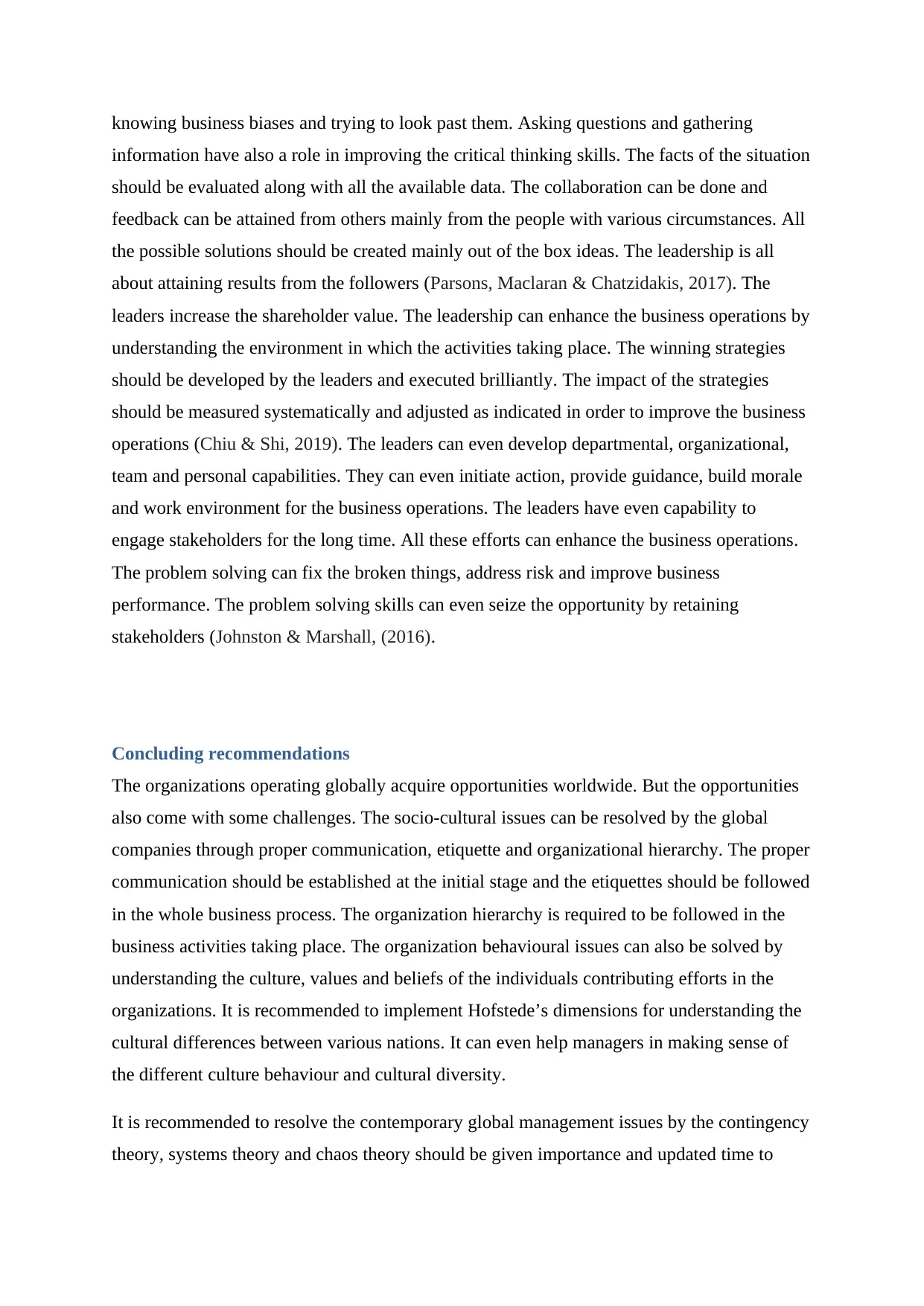
knowing business biases and trying to look past them. Asking questions and gathering
information have also a role in improving the critical thinking skills. The facts of the situation
should be evaluated along with all the available data. The collaboration can be done and
feedback can be attained from others mainly from the people with various circumstances. All
the possible solutions should be created mainly out of the box ideas. The leadership is all
about attaining results from the followers (Parsons, Maclaran & Chatzidakis, 2017). The
leaders increase the shareholder value. The leadership can enhance the business operations by
understanding the environment in which the activities taking place. The winning strategies
should be developed by the leaders and executed brilliantly. The impact of the strategies
should be measured systematically and adjusted as indicated in order to improve the business
operations (Chiu & Shi, 2019). The leaders can even develop departmental, organizational,
team and personal capabilities. They can even initiate action, provide guidance, build morale
and work environment for the business operations. The leaders have even capability to
engage stakeholders for the long time. All these efforts can enhance the business operations.
The problem solving can fix the broken things, address risk and improve business
performance. The problem solving skills can even seize the opportunity by retaining
stakeholders (Johnston & Marshall, (2016).
Concluding recommendations
The organizations operating globally acquire opportunities worldwide. But the opportunities
also come with some challenges. The socio-cultural issues can be resolved by the global
companies through proper communication, etiquette and organizational hierarchy. The proper
communication should be established at the initial stage and the etiquettes should be followed
in the whole business process. The organization hierarchy is required to be followed in the
business activities taking place. The organization behavioural issues can also be solved by
understanding the culture, values and beliefs of the individuals contributing efforts in the
organizations. It is recommended to implement Hofstede’s dimensions for understanding the
cultural differences between various nations. It can even help managers in making sense of
the different culture behaviour and cultural diversity.
It is recommended to resolve the contemporary global management issues by the contingency
theory, systems theory and chaos theory should be given importance and updated time to
information have also a role in improving the critical thinking skills. The facts of the situation
should be evaluated along with all the available data. The collaboration can be done and
feedback can be attained from others mainly from the people with various circumstances. All
the possible solutions should be created mainly out of the box ideas. The leadership is all
about attaining results from the followers (Parsons, Maclaran & Chatzidakis, 2017). The
leaders increase the shareholder value. The leadership can enhance the business operations by
understanding the environment in which the activities taking place. The winning strategies
should be developed by the leaders and executed brilliantly. The impact of the strategies
should be measured systematically and adjusted as indicated in order to improve the business
operations (Chiu & Shi, 2019). The leaders can even develop departmental, organizational,
team and personal capabilities. They can even initiate action, provide guidance, build morale
and work environment for the business operations. The leaders have even capability to
engage stakeholders for the long time. All these efforts can enhance the business operations.
The problem solving can fix the broken things, address risk and improve business
performance. The problem solving skills can even seize the opportunity by retaining
stakeholders (Johnston & Marshall, (2016).
Concluding recommendations
The organizations operating globally acquire opportunities worldwide. But the opportunities
also come with some challenges. The socio-cultural issues can be resolved by the global
companies through proper communication, etiquette and organizational hierarchy. The proper
communication should be established at the initial stage and the etiquettes should be followed
in the whole business process. The organization hierarchy is required to be followed in the
business activities taking place. The organization behavioural issues can also be solved by
understanding the culture, values and beliefs of the individuals contributing efforts in the
organizations. It is recommended to implement Hofstede’s dimensions for understanding the
cultural differences between various nations. It can even help managers in making sense of
the different culture behaviour and cultural diversity.
It is recommended to resolve the contemporary global management issues by the contingency
theory, systems theory and chaos theory should be given importance and updated time to
⊘ This is a preview!⊘
Do you want full access?
Subscribe today to unlock all pages.

Trusted by 1+ million students worldwide
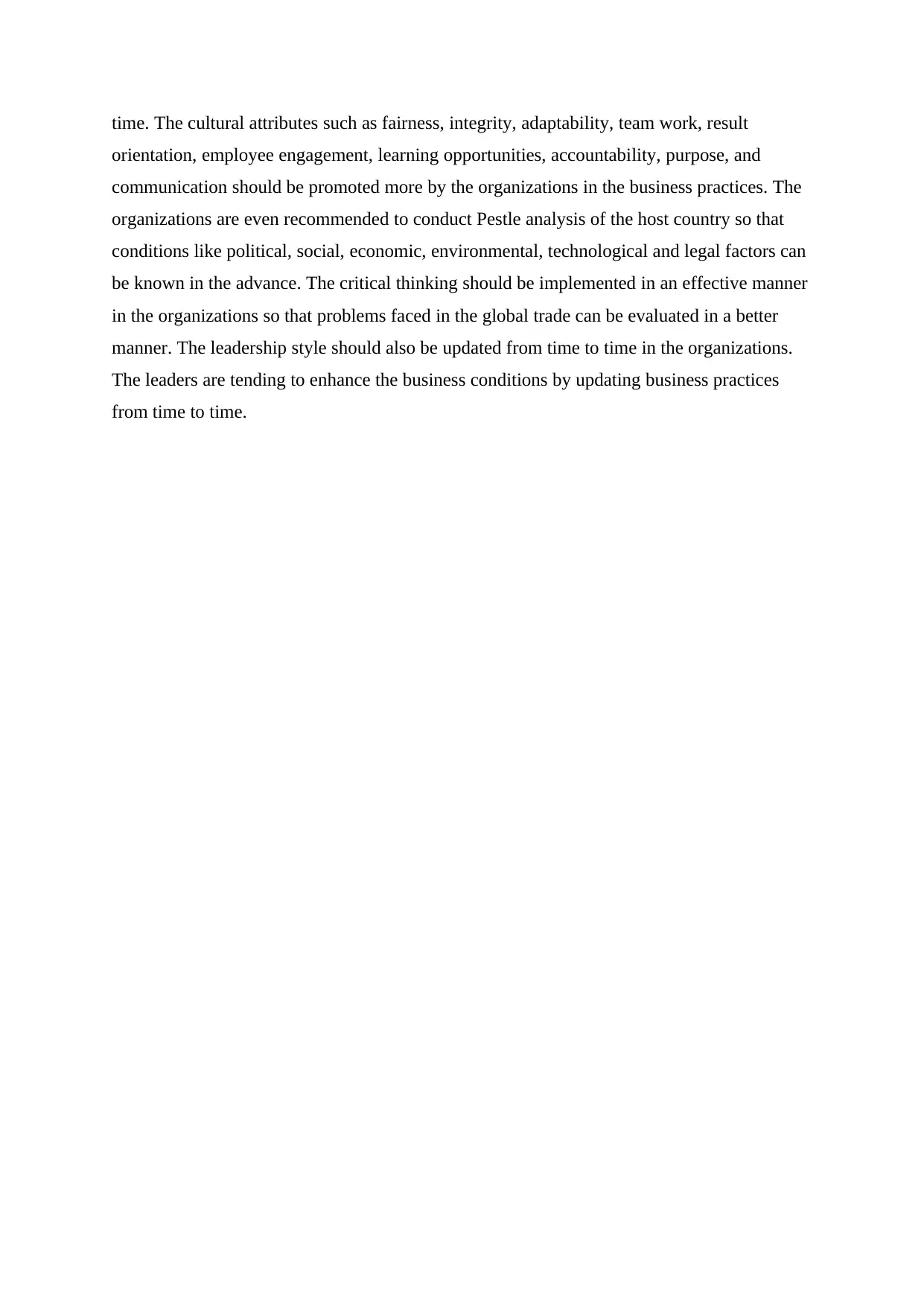
time. The cultural attributes such as fairness, integrity, adaptability, team work, result
orientation, employee engagement, learning opportunities, accountability, purpose, and
communication should be promoted more by the organizations in the business practices. The
organizations are even recommended to conduct Pestle analysis of the host country so that
conditions like political, social, economic, environmental, technological and legal factors can
be known in the advance. The critical thinking should be implemented in an effective manner
in the organizations so that problems faced in the global trade can be evaluated in a better
manner. The leadership style should also be updated from time to time in the organizations.
The leaders are tending to enhance the business conditions by updating business practices
from time to time.
orientation, employee engagement, learning opportunities, accountability, purpose, and
communication should be promoted more by the organizations in the business practices. The
organizations are even recommended to conduct Pestle analysis of the host country so that
conditions like political, social, economic, environmental, technological and legal factors can
be known in the advance. The critical thinking should be implemented in an effective manner
in the organizations so that problems faced in the global trade can be evaluated in a better
manner. The leadership style should also be updated from time to time in the organizations.
The leaders are tending to enhance the business conditions by updating business practices
from time to time.
Paraphrase This Document
Need a fresh take? Get an instant paraphrase of this document with our AI Paraphraser
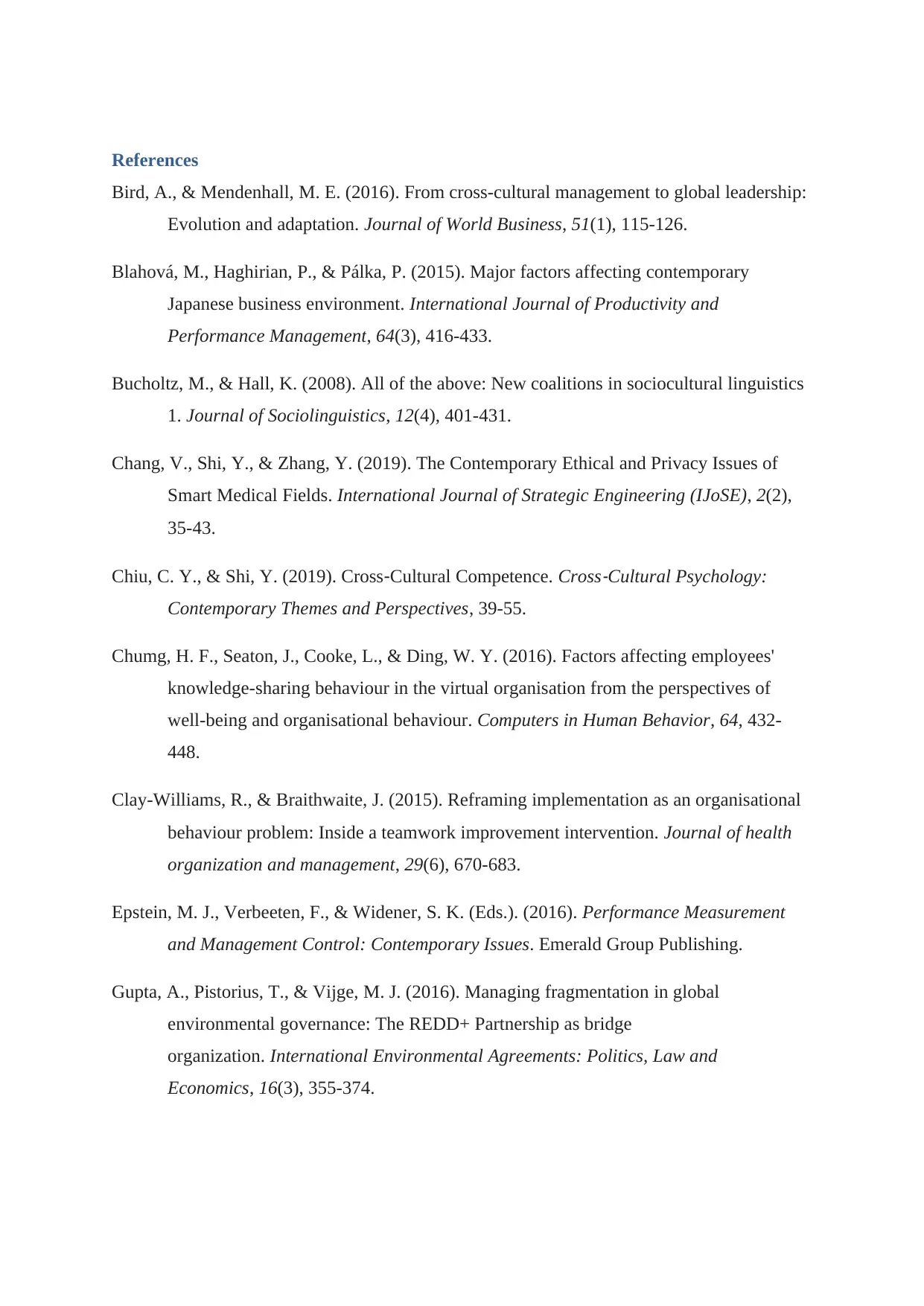
References
Bird, A., & Mendenhall, M. E. (2016). From cross-cultural management to global leadership:
Evolution and adaptation. Journal of World Business, 51(1), 115-126.
Blahová, M., Haghirian, P., & Pálka, P. (2015). Major factors affecting contemporary
Japanese business environment. International Journal of Productivity and
Performance Management, 64(3), 416-433.
Bucholtz, M., & Hall, K. (2008). All of the above: New coalitions in sociocultural linguistics
1. Journal of Sociolinguistics, 12(4), 401-431.
Chang, V., Shi, Y., & Zhang, Y. (2019). The Contemporary Ethical and Privacy Issues of
Smart Medical Fields. International Journal of Strategic Engineering (IJoSE), 2(2),
35-43.
Chiu, C. Y., & Shi, Y. (2019). Cross‐Cultural Competence. Cross
‐Cultural Psychology:
Contemporary Themes and Perspectives, 39-55.
Chumg, H. F., Seaton, J., Cooke, L., & Ding, W. Y. (2016). Factors affecting employees'
knowledge-sharing behaviour in the virtual organisation from the perspectives of
well-being and organisational behaviour. Computers in Human Behavior, 64, 432-
448.
Clay-Williams, R., & Braithwaite, J. (2015). Reframing implementation as an organisational
behaviour problem: Inside a teamwork improvement intervention. Journal of health
organization and management, 29(6), 670-683.
Epstein, M. J., Verbeeten, F., & Widener, S. K. (Eds.). (2016). Performance Measurement
and Management Control: Contemporary Issues. Emerald Group Publishing.
Gupta, A., Pistorius, T., & Vijge, M. J. (2016). Managing fragmentation in global
environmental governance: The REDD+ Partnership as bridge
organization. International Environmental Agreements: Politics, Law and
Economics, 16(3), 355-374.
Bird, A., & Mendenhall, M. E. (2016). From cross-cultural management to global leadership:
Evolution and adaptation. Journal of World Business, 51(1), 115-126.
Blahová, M., Haghirian, P., & Pálka, P. (2015). Major factors affecting contemporary
Japanese business environment. International Journal of Productivity and
Performance Management, 64(3), 416-433.
Bucholtz, M., & Hall, K. (2008). All of the above: New coalitions in sociocultural linguistics
1. Journal of Sociolinguistics, 12(4), 401-431.
Chang, V., Shi, Y., & Zhang, Y. (2019). The Contemporary Ethical and Privacy Issues of
Smart Medical Fields. International Journal of Strategic Engineering (IJoSE), 2(2),
35-43.
Chiu, C. Y., & Shi, Y. (2019). Cross‐Cultural Competence. Cross
‐Cultural Psychology:
Contemporary Themes and Perspectives, 39-55.
Chumg, H. F., Seaton, J., Cooke, L., & Ding, W. Y. (2016). Factors affecting employees'
knowledge-sharing behaviour in the virtual organisation from the perspectives of
well-being and organisational behaviour. Computers in Human Behavior, 64, 432-
448.
Clay-Williams, R., & Braithwaite, J. (2015). Reframing implementation as an organisational
behaviour problem: Inside a teamwork improvement intervention. Journal of health
organization and management, 29(6), 670-683.
Epstein, M. J., Verbeeten, F., & Widener, S. K. (Eds.). (2016). Performance Measurement
and Management Control: Contemporary Issues. Emerald Group Publishing.
Gupta, A., Pistorius, T., & Vijge, M. J. (2016). Managing fragmentation in global
environmental governance: The REDD+ Partnership as bridge
organization. International Environmental Agreements: Politics, Law and
Economics, 16(3), 355-374.
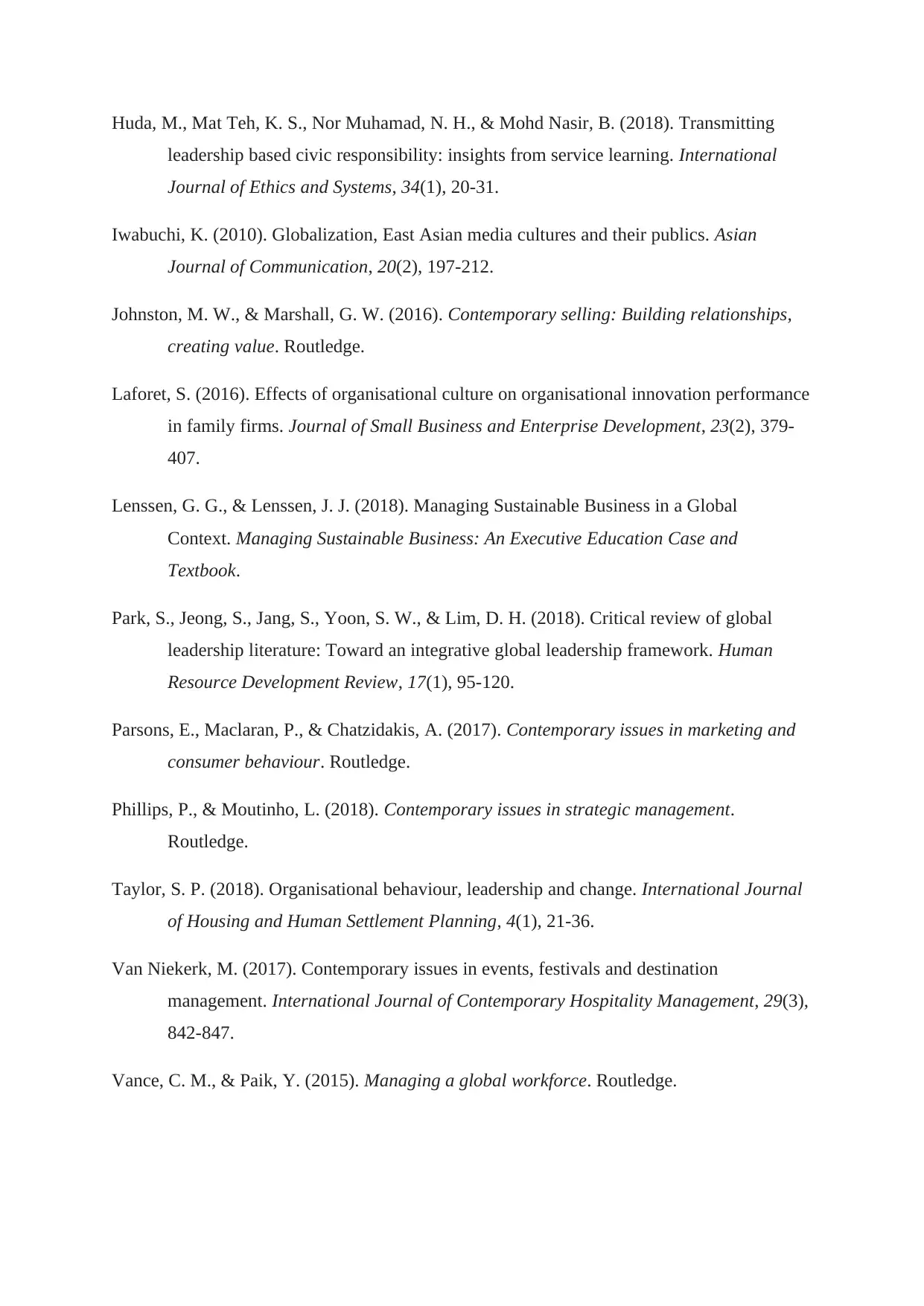
Huda, M., Mat Teh, K. S., Nor Muhamad, N. H., & Mohd Nasir, B. (2018). Transmitting
leadership based civic responsibility: insights from service learning. International
Journal of Ethics and Systems, 34(1), 20-31.
Iwabuchi, K. (2010). Globalization, East Asian media cultures and their publics. Asian
Journal of Communication, 20(2), 197-212.
Johnston, M. W., & Marshall, G. W. (2016). Contemporary selling: Building relationships,
creating value. Routledge.
Laforet, S. (2016). Effects of organisational culture on organisational innovation performance
in family firms. Journal of Small Business and Enterprise Development, 23(2), 379-
407.
Lenssen, G. G., & Lenssen, J. J. (2018). Managing Sustainable Business in a Global
Context. Managing Sustainable Business: An Executive Education Case and
Textbook.
Park, S., Jeong, S., Jang, S., Yoon, S. W., & Lim, D. H. (2018). Critical review of global
leadership literature: Toward an integrative global leadership framework. Human
Resource Development Review, 17(1), 95-120.
Parsons, E., Maclaran, P., & Chatzidakis, A. (2017). Contemporary issues in marketing and
consumer behaviour. Routledge.
Phillips, P., & Moutinho, L. (2018). Contemporary issues in strategic management.
Routledge.
Taylor, S. P. (2018). Organisational behaviour, leadership and change. International Journal
of Housing and Human Settlement Planning, 4(1), 21-36.
Van Niekerk, M. (2017). Contemporary issues in events, festivals and destination
management. International Journal of Contemporary Hospitality Management, 29(3),
842-847.
Vance, C. M., & Paik, Y. (2015). Managing a global workforce. Routledge.
leadership based civic responsibility: insights from service learning. International
Journal of Ethics and Systems, 34(1), 20-31.
Iwabuchi, K. (2010). Globalization, East Asian media cultures and their publics. Asian
Journal of Communication, 20(2), 197-212.
Johnston, M. W., & Marshall, G. W. (2016). Contemporary selling: Building relationships,
creating value. Routledge.
Laforet, S. (2016). Effects of organisational culture on organisational innovation performance
in family firms. Journal of Small Business and Enterprise Development, 23(2), 379-
407.
Lenssen, G. G., & Lenssen, J. J. (2018). Managing Sustainable Business in a Global
Context. Managing Sustainable Business: An Executive Education Case and
Textbook.
Park, S., Jeong, S., Jang, S., Yoon, S. W., & Lim, D. H. (2018). Critical review of global
leadership literature: Toward an integrative global leadership framework. Human
Resource Development Review, 17(1), 95-120.
Parsons, E., Maclaran, P., & Chatzidakis, A. (2017). Contemporary issues in marketing and
consumer behaviour. Routledge.
Phillips, P., & Moutinho, L. (2018). Contemporary issues in strategic management.
Routledge.
Taylor, S. P. (2018). Organisational behaviour, leadership and change. International Journal
of Housing and Human Settlement Planning, 4(1), 21-36.
Van Niekerk, M. (2017). Contemporary issues in events, festivals and destination
management. International Journal of Contemporary Hospitality Management, 29(3),
842-847.
Vance, C. M., & Paik, Y. (2015). Managing a global workforce. Routledge.
⊘ This is a preview!⊘
Do you want full access?
Subscribe today to unlock all pages.

Trusted by 1+ million students worldwide
1 out of 13
Related Documents
Your All-in-One AI-Powered Toolkit for Academic Success.
+13062052269
info@desklib.com
Available 24*7 on WhatsApp / Email
![[object Object]](/_next/static/media/star-bottom.7253800d.svg)
Unlock your academic potential
Copyright © 2020–2025 A2Z Services. All Rights Reserved. Developed and managed by ZUCOL.





